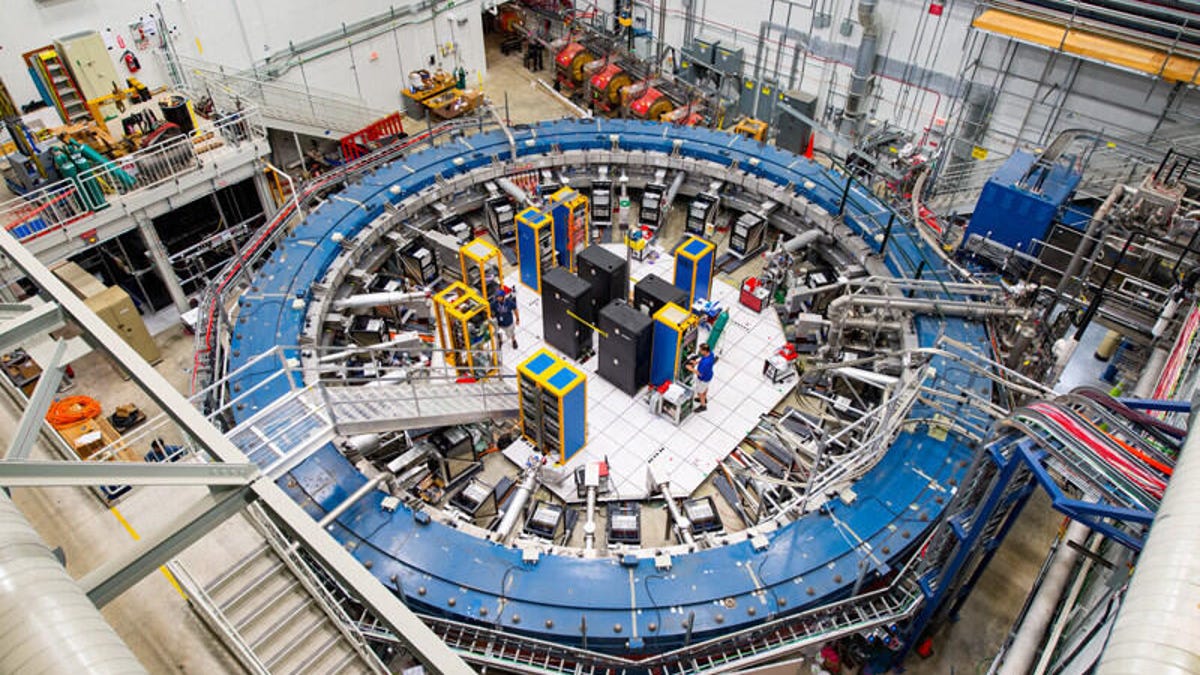Subatomic muon particles' weird wobble might break the laws of physics
Something unseen is influencing muons, and the findings could lead to a bigger quantum uproar than the Higgs boson did.

The Muon g-2 ring sits in its detector hall amid electronics racks, the muon beamline and other equipment. This experiment operates at minus 450 degrees Fahrenheit and studies the precession (or wobble) of muons as they travel through the magnetic field.
When you fire up the Large Hadron Collider and use its globally supreme power to demolition-derby a couple of ordinary particles together, not only can you create a mind-boggling collision force of 13 teraelectronvolts. You might also find you've produced a subatomic particle whose strange wobbling might break the laws of physics altogether.
It's called a muon. And on Wednesday, researchers at the Fermi National Accelerator Laboratory sent shock waves through the world of particle physics when they found this unassuming speck of quantum-curious existence could illuminate the very fabric of the universe in a way we haven't seen since the discovery of the Higgs boson nearly a decade ago.
At 207 times bigger than electrons, the magnet-like muons radioactively decay in 2.2 millionths of a second, making them unlikely candidates for an explosive physics discovery, according to a richly reported New York Times story Wednesday. In the Standard Model of particle physics, which explains how the universe's elementary particles interact, we have very stringent calculations as to how muons should move.
But during experiments at the Fermi Lab, researchers noticed the muons wobbling weirdly. So weirdly that the wobbles routinely defy the world's most hyper-specific measurements and go against the standard model. They appear to be influenced by what physicists say may be forces outside of those currently known.
"This quantity we measure reflects the interactions of the muon with everything else in the universe," said Renee Fatemi, a physicist at the University of Kentucky, in a release. "This is strong evidence that the muon is sensitive to something that is not in our best theory."
In quantum physics, a theory holds that particles can suddenly appear and influence an item they interact with before disappearing again. Researchers working on muons say the tiny variations in the muons' wobbles can be attributed to the influence of a potential host of these "virtual particles."
Although the findings follow in the footsteps of similar experiments in 2013 and 2018, the latest results still require more vetting. The researchers note the chances of the muon's wobbling being a statistical fluke is about one in 40,000 -- which, in science-talk, equates to a confidence level of "4.1 sigma." Physicists usually aren't satisfied until the confidence level reaches 5 sigma.
In the meantime, however, you can find more on the mind-blowing muons by checking out Fermilab's ordinary-folk-friendly video explainer.
Read more: CERN wants to build a new $23 billion super-collider that's 100 kilometers long

